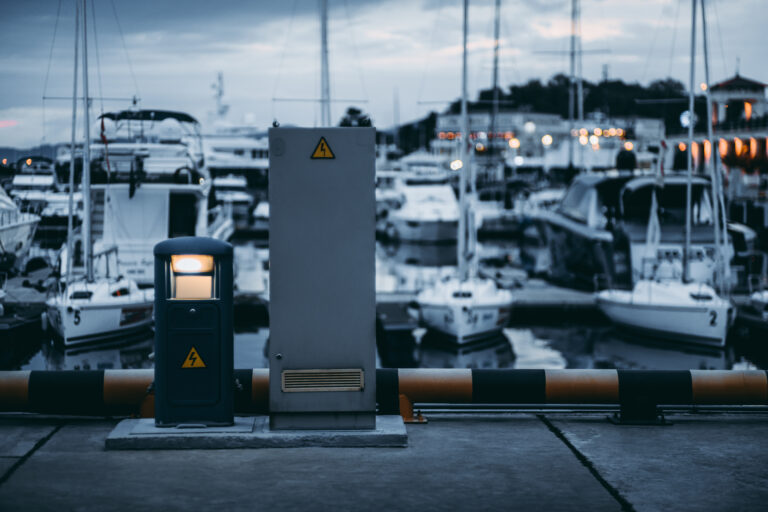The Maritime and Port Authority of Singapore (MPA) has launched its first pilot trial for an electric harbor craft (e-HC) charging point at the Marina South Pier (MSP), following an earlier call for proposals (CFP) to develop and operate e-HC charging points at various locations under a two-year pilot scheme.
The charging point at MSP was awarded to the Pyxis Energy, Pyxis Maritime and SP Mobility partnership. Pyxis’s fleet of e-HCs operating at MSP will serve as the base offtake to ensure optimization of the charging infrastructure and enable comprehensive data to be gathered. Insights from the data collected will contribute toward the development of a national e-HC charging infrastructure masterplan, implementation plan, and national standards for e-HC charging infrastructure.
Battery capacity
Under this pilot, the Pyxis and SP Mobility partnership has deployed a 150kW land-based direct current (DC) fast charger with a combined charging system 2 connector at MSP. This charger can charge an e-HC with an approximate battery capacity of 500kWh in around three hours and enable an operating range of about 50 nautical miles, about 90km. Users of the e-HC charger will need to scan a QR code using the SP app and make the payment via the app, similar to users of electric vehicles.
MPA is working with Enterprise Singapore, industry stakeholders and academia to develop a technical reference (TR) for e-HC charging and battery swap system. The draft TR will be ready for public consultation by mid-April 2024.
Capt M Segar, MPA assistant chief executive of operations, said, “Public-private partnership is key to promote wider adoption of e-HC in Singapore, including working together to improve the e-HC vessel and battery designs, support development of the technical standard, lower financing barriers, and building the charging infrastructure to give confidence to users and encourage wider adoption.”
Tommy Phun, founder of Pyxis, said, “We are delighted to announce the commencement of charging operations at Marina South Pier for the X Tron, the inaugural vessel from Pyxis’s flagship product line, the Pyxis One series of electric vessels. Tailored specifically for the dynamic Singapore port market, the Pyxis One seamlessly shuttles passengers between mainland Singapore and ships stationed at the anchorage. With a purpose-built aluminum catamaran hull, an efficient electric propulsion chain, and an IoT-enabled digital ecosystem platform, the Pyxis One pushes the boundaries of innovation and brings significant productivity gains compared to traditional diesel vessels. In addition to our electric harbor craft meeting Singapore’s 2030 and 2050 targets early, there is also expected total ownership cost savings compared to our traditional vessels.”
Dean Cher, head of mobility and sustainable energy solutions at SP Group, said, “We are committed to leading the decarbonization of the transport sector, from land to sea, cars to harbor craft. This very first public marine charging point at Marina South Pier is a small but important step in providing the marine industry with decarbonization options and our partnership with Pyxis will lead the way to wider e-HC adoption in Singapore.”
In addition to the Pyxis and SP Mobility partnership, MPA has also awarded a mobile charging concept proposed by Seatrium O&G (International) and a high power (350kW-450kW) DC charger proposed by Yinson Electric. MPA will continue to work with the two companies to further develop their proposals for applications in Singapore.
Sustainable operations
From 2030, all new harbor craft operating in the Port of Singapore will have to be fully electric, be capable of using B100 biofuel, or be compatible with net-zero fuels such as hydrogen. For biofuels, blends of up to B50 are already commercially available. MPA is working with industry to develop the standards for up to B100.
MPA recently shortlisted 11 passenger launch and cargo lighter vessel designs following an expression of interest launched for e-HC designs. These designs will be further enhanced and progressively marketed to aggregate demand from the industry to help lower production cost for companies.
The expanded Enterprise Financing Scheme-Green (EFS-Green) was recently announced at the Committee of Supply Debate 2024. From April 2024, harbor craft owners and operators may apply for loans with risk-share of 70% by participating financial institutions. Maritime companies can also tap the Energy Efficiency Grant by end-2024, which will provide two tiers of support for energy-efficient equipment. Under the base tier, they can receive up to 70% co-funding for pre-approved energy efficient domestic port and harbor craft equipment until March 2026. Across both tiers, they can receive up to S$350,000 (US$260,000) per company support.
In related news, Associated British Ports (ABP) recently welcomed a delegation from the Maritime and Port Authority of Singapore (MPA) to the Port of Southampton, led by Teo Eng Dih, chief executive of MPA. Click here to read the full story.



